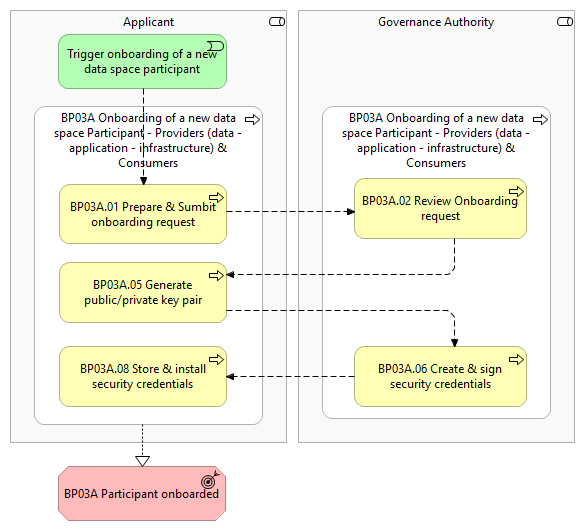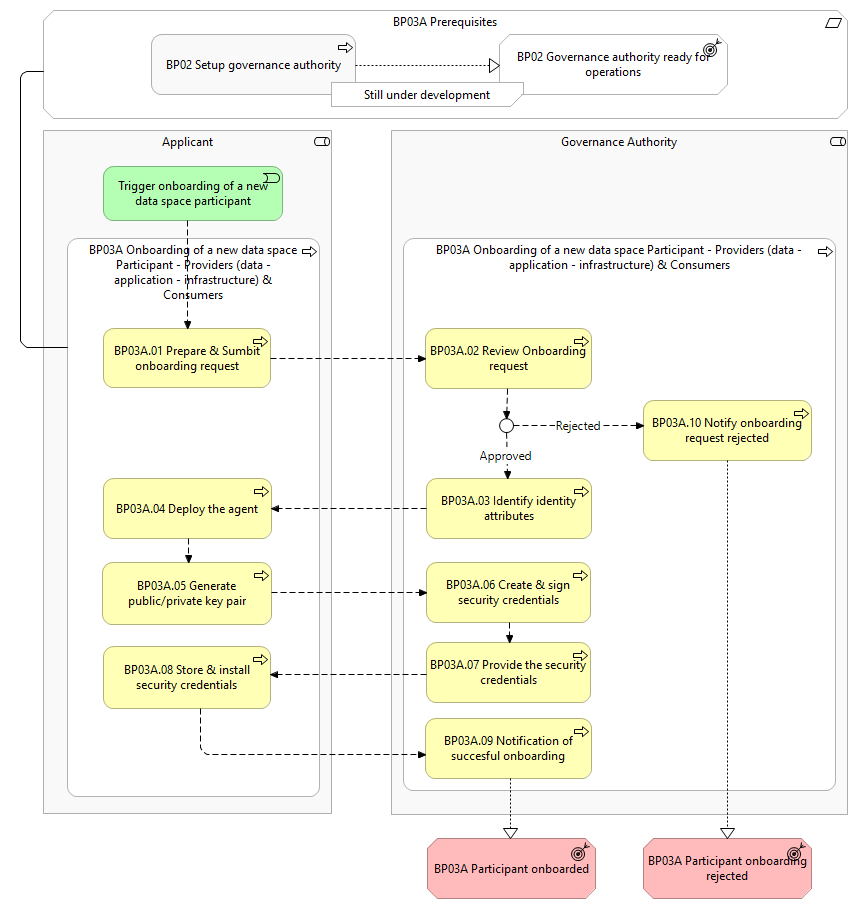BP03A – Onboarding of a new data space Participant - Providers (data - application - infrastructure) & Consumers
To help understand the content of this document, readers should familiarize themselves with the key definitions and actors.
Overview

This business process covers the onboarding process for a new Applicant. Both Providers and Consumers can apply to a data space and will be referred to as (data space) Applicants from here on.
It includes the following main steps:
- Prepare & submit onboarding request: The Applicant submits the onboarding requests to the Governance Authority for review.
- Review onboarding request: The Governance Authority verifies the Applicant’s onboarding request against a predefined set of criteria and the alignment with the data space objectives.
- Generate public/private keypair: The Applicant deploys and configures the Simpl-Open agent and uses the agent to generate a public/private key pair to enable encrypted communications and data integrity within the data space.
- Create & sign security credentials: The Governance Authority creates and signs digital security credentials (e.g., x.509 certificates) that incorporate the Applicant’s public key. These credentials serve as proof of identity and are validated through the issuance of certifications by the Governance Authority. The certifications ensure that the credentials are securely linked to the correct entity.
- Store & install security credentials: The Applicant stores and installs the signed identity security credentials in its Simpl-Open Agent.
Actors
The following actors are involved:
- Governance Authority
- Applicant
Assumptions
The following assumptions are made:
- Data space Applicants are assumed to be an organisation and not an individual person.
- The person/people acting on behalf of the Applicant, applying to the data space are assumed to be a member of the Applicant organisation's directory.
- Data space specifications: The document(s) describing the data space’s objectives, candidature criteria and requirements applicable to an organisation for onboarding are developed and available to a potential Applicant (e.g., website publication).
Prerequisites
The following prerequisites must be fulfilled:
- Data space is configured: The Governance Authority has defined the onboarding procedure and identity attributes relevant for the data space (Business Process 2).
Details
The following shows the detailed business process diagram and gives the step descriptions.

Trigger onboarding of a new data space Participant
The Participant initiates the preparation and submission of the onboarding request.
BP03A.01 Prepare & submit onboarding request
The Applicant prepares a comprehensive application to participate to the data space, by gathering the required information based on the documentation made available by the Governance Authority (see prerequisite 1). After the preparation of the onboarding request, the Applicant fills in the forms and provides any other documents that may be mandatory (following the rules that are defined by the Governance Authority) to the Governance Authority for review.
BP03A.02 Review onboarding request
After receiving the onboarding request, the Governance Authority starts the review process. It verifies the Applicant’s onboarding request against a predefined set of criteria and the alignment with the data space objectives (see prerequisite 1). The review process of the onboarding request can be either manually or automatically done by the Governance Authority. As an outcome of this step:
- The Governance Authority can approve the onboarding request. If the request is approved, the process continues to the identification of identity attributes in step BP03A.03.
- The Governance Authority reject the onboarding request. If the request is rejected, the process notifies the Applicant about the rejection in step BP03A.11.
- In case deficiencies are found, the Applicant shall also have the possibility to address them and start over the process from Step BP3A.01.
BP03A.03 Identify identity attributes
As part of the approval process the Governance Authority identifies the relevant identity attributes of the Applicant that will be used for authentication of the Applicant.
BP03A.04 Agent deployment
If the application is approved, the Applicant downloads the minimal set of modules from Simpl-Open that are required to have an operative Simpl-Open. The Applicant then deploys and configures the Simpl-Open modules on the Applicant's infrastructure to establish the necessary environment for participating within the data space.
BP03A.05 Generate public/private keypair
The Applicant's agent generates a public/private key pair to enable encrypted communications and data integrity within the data space. The private key is securely stored in the Simpl-Open agent. The Applicant shares the public key with the Governance Authority to request signed security credentials.
BP03A.06 Create & sign security credentials
The Governance Authority creates and signs digital security credentials (e.g., x.509 certificates) that incorporate the Applicant’s public key. These credentials serve as proof of identity and are validated through the issuance of certifications by the Governance Authority. The certifications ensure that the credentials are securely linked to the correct entity.
BP03A.07 Provide the security credentials
The Governance Authority provides the signed security credentials to the Applicant. The security credentials are essential to ensure secure operations within the data space.
BP03A.08 Store & install security credentials
The Applicant stores and installs the signed identity security credentials in its Simpl-Open Agent.
BP03A.09 Notification of successful onboarding
The Applicant is notified that they are now fully onboarded to the data space and from now on are a Participant.
BP03A.10 Notify onboarding request rejected
The Applicant is notified that their onboarding request has been rejected.
Outcomes
- Participant onboarded: The Participant onboarding has been completed and the Participant is fully onboarded.
- Participant onboarding rejected: The Participant onboarding has been rejected and cannot join the data space.
| Business Process | Status: Proposed |
High Level Requirements
3A.1 - Onboarding of a new data space participant - registration of onboarding request
Simpl should allow the Dataspace Governance Authority to define rules for the ...3A.2 - Onboarding of a new data space participant - review of the onboarding request
Simple shall provide support for the review of the onboarding requests as follows ...3A.3 - Onboarding of a new data space participant - finalizing onboarding
Simpl shall provide support for the following: ...3A.4 - Onboarding of a new data space participant - attribute placement during onboarding
Simpl shall provide support to position identity attributes according to the ...

Moderator note: Comments are from the previous discussion platform.
Submitted by Luis Carlos BU… on Mon, 25/03/2024 - 14:34
The Description of the high-level requirement should also include provision for the possible withdrawal of participants in Dataspaces
Submitted by Javier VALIÑO on Tue, 02/07/2024 - 15:12
Looking at the diagram, it seems it is following a centralised approach where the Governance Authority is issuing the security credentials.
Is there a plan to support decentralised approaches such as Verifiable Credentials/DIDs as described by Gaia-X (https://www.gaiax.es/sites/default/files/2023-04/Gaia-X_Architecture_Do… section 4,6)?
In reply to Looking at the diagram, it… by Javier VALIÑO
Submitted by Rick Santbergen on Mon, 15/07/2024 - 14:52
Hi Javier, the credential issued by the Dataspace Governance Authority only has the purpose of implementing a secure mTLS channel of communication between participant Agents (tier 2 agent-to-agent communication), which ensures the highest level of security. Besides that, all operations/functionalities such as signing a service offering, consuming a service offering, signing contracts, and giving consent, etc., will be following the decentralised approach (VC/DID) as described by Gaia-X.
Submitted by Mark Dietrich on Thu, 04/07/2024 - 14:06
As discussed in Simpl workshop -- process should reflect organisations' having individuals who are authorized to make an application (able to prove they have the authority), as well as the fact that different individuals will be involved at different points (e.g. the Rector of KU Leuven will not install software).
In reply to As discussed in SIMPL… by Mark Dietrich
Submitted by Rick Santbergen on Thu, 25/07/2024 - 10:30
Hi Mark, all tasks related to legal identities, authentication/authorisation, and legally binding signatures fall outside the scope of the onboarding procedure. Approval for onboarding occurs after validation through secondary channels, which may include document verification, contract signing, and other requirements set by the Dataspace Governance Authority.
Submitted by Andreas Eisenrauch on Fri, 16/08/2024 - 11:02
I am not sure, if the human end users are really relevant for the data space governance authority. I have doubt, that they will acquire connectors for getting an airlines flight schedule or a museum catalogue directly from the source. Instead, they will register to applications (developed in use case projects) provided by corporate participants, which retrieve the data from partners in the DS. I think this, item has no high priority at least.
Please log in or sign up to comment.